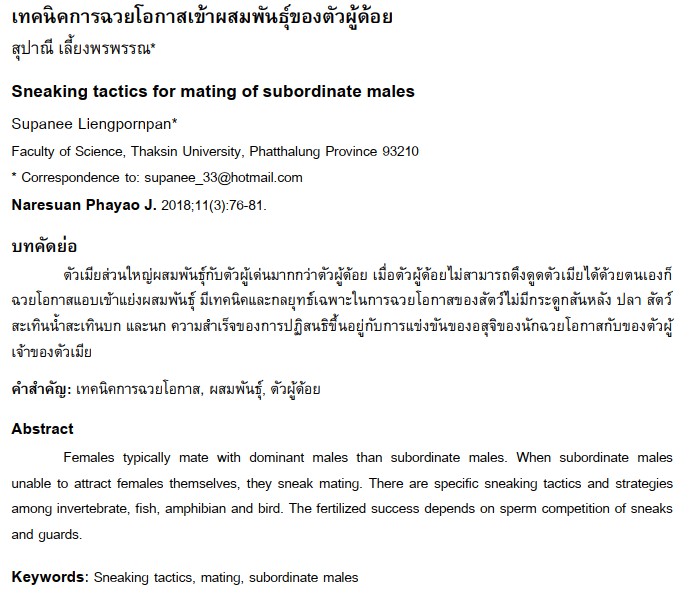Sneaking tactics for mating of subordinate males
Keywords:
Sneaking tactics, mating, subordinate malesAbstract
Females typically mate with dominant males than subordinate males. When subordinate males unable to attract females themselves, they sneak mating. There are specific sneaking tactics and strategies among invertebrate, fish, amphibian and bird. The fertilized success depends on sperm competition of sneaks and guards.
References
2. Berglund A. Armaments and ornaments: an evolutionary explanation of traits of dual utility. Biol J Linnean Soc. 1996;58:385-99.
3. Gross MR. Alternative reproductive strategies and tactics: diversity within sexes. TREE. 1996;11(2):92-8.
4. Emlen DJ. Alternative reproductive tactics and male-dimorphism in the horned beetle Onthophagus acuminatus (Coleoptera: Scarabaeidae). Behav Ecol Sociobiol. 1997;41(5):335-41.
5. Polak M. Competition for landmark territories among male Polistes canadensis (L.) (Hymenoptera: Vespidae): large-size advantage and alternative mate-acquisition tactics. Behav Ecol. 1993;4(4):325-31.
6. Radwan J. The Adaptive Significance of Male Polymorphism in the acarid mite Caloglyphus berlesei. Behav Ecol Sociobiol. 1993;33(3):201-8.
7. Shuster SM, Wade MJ. Equal mating success among male reproductive strategies in a marine isopod. Nature. 1991;350:608-610.
8. Damiens D, Boivin G. Why do sperm-depleted parasitoid males continue to mate? Behav Ecol. 2006;17(1):138-43.
9. Evans JP, Marshall DJ. Male-by-female interactions influence fertilization success and mediate the benefits of polyandry in the sea uechin Heliocidaris erythrogramma. Evolution. 2005;59(1):106-12.
10. Cook DF. Differences in courtship, mating and postcopulatory behaviour between male morphs of the dung beetle Onthophagus binodis Thunberg (Coleoptera: Scarabaeidae). Anim Behav. 1990;40(3):428-36.
11. Danforth BN. The morphology and behavior of dimorphic males in Perdita portalis (Hymenoptera: Andrenidae). Behav Ecol Sociobiol. 1991;29(4):235-47.
12. Moore AJ, Moore PJ. Balancing sexual selection through opposing mate choice and male competition. Proc Biol Sci. 1999;266(1420):711-6.
13. Taborsky M. Sneakers, satellites, and helpers: parasitic and cooperative behavior in fish reproduction. Adv Study Behav. 1994;23:1-100.
14. Ros AFH, Bouton N, Santos RS, Oliveira RF. Alternative male reproductive tactics and the immunocompetence handicap in the Azorean rock-pool blenny, Parablennius parvicornis, Proc R Soc B. 2006;273(1589):901-9.
15. Oliveira RF, Carvalho N, Miranda J, Goncalves EJ, Grober M, Santos RS. The relationship between the presence of satellite males and nest-holders' mating success in the Azorean rock-pool blenny Parablennius sanguinolentus parvicornis, Ethology. 2002;108(3):223-35.
16. Santos RS, Nash RDM. Seasonal variations of injuries suffered by individuals of the Azorean rock-pool blenny (Parablennius sanguinolentus parvicornis), Copeia. 1996;1996(1):216-9.
17. Brantley RK, Bass AH. Alternative male spawning tactics and acoustic signals in the plainfin midshipman fish Porichthys notatus Girard (Teleostei, Batrachoididae). Ethology. 1994;96(3):213-32.
18. Bass A. Dimorphic male brains and alternative reproductive tactics in a vocalizing fish. Trends Neurosci. 1992;15(4):139-45.
19. Brantley RK, Wingfield JC, Bass AH. Sex steroid levels in Porichthys notatus, a fish with alternative reproductive tactics, and a review of the hormonal bases for male dimorphism among teleost fishes. Horm Behav. 1993;27(3):332-47.
20. Reichard M, Bryja J, Ondrackova M, Davidova M, Kaniewska P, Smiths C. Sexual selection for male dominance reduces opportunities for female mate choice in the European bitterling (Rhodeus sericeus). Mol Ecol. 2005;14(5):1533-42.
21. Blanchfield PJ, Ridgway MS. The cost of peripheral males in a brook trout mating system. Anim Behav. 1999;57(3):537-44.
22. Fu P, Neff BD, Gross MR. Tactic-specific success in sperm competition. Proc Biol Sci. 2001;268(1472):1105-12.
23. Alonzo SH, Warner RR. A trade-off generated by sexual conflict: Mediterranean wrasse males refuse present mates to increase future success. Behav Ecol. 1999;10(1):105-11.
24. Alonzo SH, Warner RR. Dynamic games and field experiments examining intra- and intersexual conflict: explaining counterintuitive mating behavior in a Mediterranean wrasse, Symphodus ocellatus. Behav Ecol. 2000;11(1):56-70.
25. van den Berghe EP, Wernerus F, Warner RR. Female choice and the mating cost of peripheral males. Anim Behav. 1989;38(5):875-84.
26. Zimmerer EJ, Kallman KD. Genetic basis for alternative reproductive tactics in the pygmyswordtail, Xiphophorus nigrensis. Evolution. 1989;43(6):1298-307.
27. Erbelding-Denk C, Schroder JH, Schartl M, Nanda I, Schmid M, Epplen JT. Male polymorphism in Limia perugiae (Pisces: Poeciliidae). Behav Genet. 1994;24(1):95-101.
28. Evans JP, Zane L, Francescato S, Pilastro A. Directional postcopulatory sexual selection revealed by artificial insemination. Nature. 2003;421(6921):360-3.
29. Taborsky M. Sperm competition in fish: Bourgeois males and parasitic spawning. Trends Ecol Evol. 1998;13(6):222-7.
30. Parker GA. Sperm competition games: sneaks and extra-pair copulations. Proc R Soc Lond B. 1990;242(1304):127-33.
31. Godin JJ. Predation risk and alternative mating tactics in male Trinidadian guppies (Poecilia reticulata). Oecologia. 1995;103(2):224-9.
32. Reynolds JD, Gross MD, Coombs MJ. Environmental conditions and male morphology determine alternative mating behavior in Trinidadian guppies. Anim Behav. 1993;45(1):145-52.
33. Howard RD. Alternative mating behaviors oh young male bullfrogs. Amer Zool. 1984;24:397-406.
34. Perrill SA, Gerhardt HC, Daniel R. Sexual parasitism in the green tree frog (Hyla cinerea). Science. 1978;200(4346):1179-80.
35. Davies NB, Halloday TR. Competitive mate searching in male common toads Bufo bufo. Anim Behav. 1979;27(Pt 4):1253-67.
36. Byrne PG, Roberts JD. Simultaneous mating with multiple males reduces fertilization success in the myobatrachid frog Crinia Georgiana. Proc Biol Sci. 1999;266(1420):717-21.
37. Byrne PG, Roberts JD. Does multiple paternity improve fitness of the frog Crinia Georgiana? Evolution. 2000;54(3):968-73.
38. Hoglund J, Lundberg A. Plumage color correlates with body size in the ruff (Philomachus pugnax). Auk. 1989;106(2):336-8.
39. van Rhijn J. Behavioural dimorphism in male ruffs, Philomachus pugnax (L.), Behaviour. 1973;47(34):153-229.
40. Slagsvold T, Saetre G. Evolution of plumage color in male pied flycatchers (Ficedula hypoleuca): evidence for female mimicry. Evolution. 1991;45(4):910-7.

Downloads
Published
How to Cite
Issue
Section
License
ผู้นิพนธ์ต้องรับผิดชอบข้อความในบทนิพนธ์ของตน มหาวิทยาลัยพะเยาไม่จำเป็นต้องเห็นด้วยกับบทความที่ตีพิมพ์เสมอไป ผู้สนใจสามารถคัดลอก และนำไปใช้ได้ แต่จะต้องขออนุมัติเจ้าของ และได้รับการอนุมัติเป็นลายลักษณ์อักษรก่อน พร้อมกับมีการอ้างอิงและกล่าวคำขอบคุณให้ถูกต้องด้วย
The authors are themselves responsible for their contents. Signed articles may not always reflect the opinion of University of Phayao. The articles can be reproduced and reprinted, provided that permission is given by the authors and acknowledgement must be given.







